Continuing my series of posts of my pictures from 1978 which will eventually include all of the selected photographs I took in London in 1978 and posted recently on Facebook with comments, and a few related images. All of these pictures (and more) are in my London Pictures web site, and eventually I intend to add the comments there too.
Click on any image to go to the web page with a slightly larger picture.
__________________________________________
London 1978 (2)
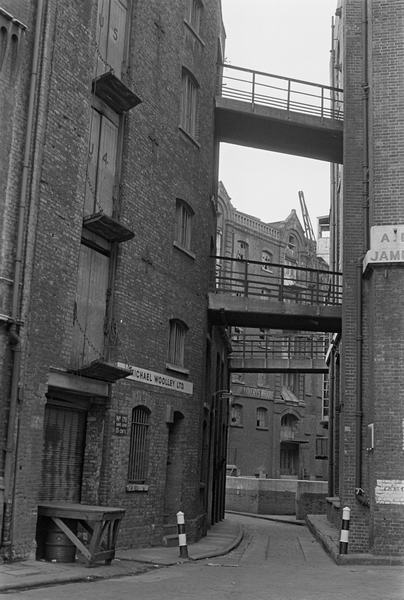
Rosings’ Wharf (once part of West Kent Warehouses) and St Mary Overy’s Wharf, Southwark, 1978
14v61: Southwark, wharves, Victorian
This time I am sure where the picture was taken, as the background building has a name on it, which is St Mary Overy’s Wharf and in front of it is the wall at the end of the dock. The building at left is Rosing’s Wharf, and at the right is a part of the sign on West Kent Warehouses. The next frame makes this even clearer, taken from a similar position but with a wider lens it shows the whole sign, AD 1858 James Hartley & Compy. Messrs. Rosing Brothers & Co., coffee cleaners and merchants took over the building and renamed West Kent Mill in 1891.
Rosing’s Wharf has the name Michael Wooley Ltd, and a sign on the wall gives the safe working limit for the hoist to the upper floors of 15 cwts – 15 hundredweights or three-quarters of a ton. Wooley was a wine importer and the building was still in use until 1979, the year after I photographed it. Rosings took over this building in 1890. It had been built around 50 years earlier and used for storage of various foodstuffs and for feathers, and, from 1872 for Danish bacon, butter and cheese.
The premises were taken over by the Proprietors of Hay’s Wharf in 1921 and used by them until 1964. Michael Wooley Ltd moved in, putting in new offices and toilets in 1967 and the building was demolished in 1983.
Although called wharves, buildings such as Rosing’s Wharf had no direct river access. Goods would be landed from lighters at nearby wharves or docks – such at the St Mary Overy Dock a few yards away – and then brought by cart or lorry for storage.
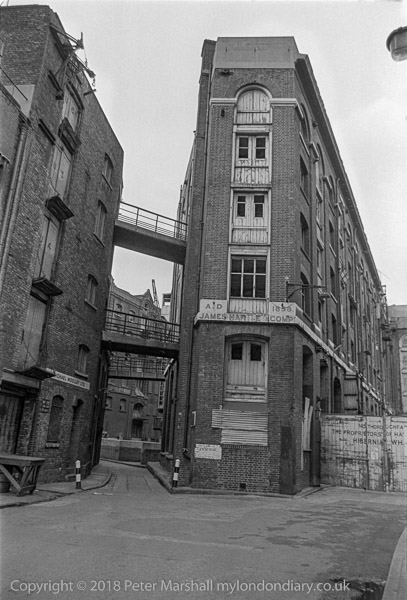
Rosings’ Wharf and West Kent Warehouses, Southwark, 1978
14v62: Southwark, wharves, Victorian
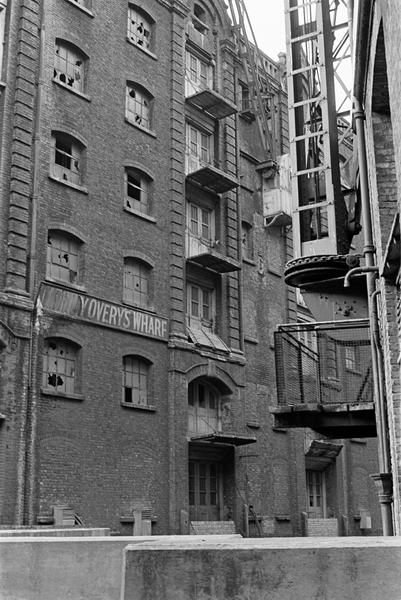
Rosings’ Wharf (once part of West Kent Warehouses) and St Mary Overie Wharf, Southwark, 1978
14v65: Southwark, wharves, Victorian
The concrete wall visible here in the foreground (and further back in the above images) is the dock wall for the dock which now holds the replica Golden Hind. Like other walls along this part of the Thames it was raised at this time to help prevent flooding.
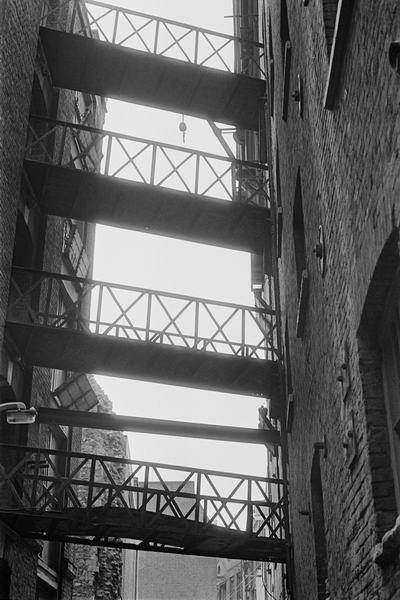
Pickford’s Wharf, Southwark, 1978
14v53: Southwark, wharves, Victorian
There was an area of small alleys and streets close to Southwark Cathedral which I wandered around, and it is hard to know precisely where this photograph was taken. There were overhead bridges between a number of the warehouses in this area, including Rosings’ Wharf and Stave Wharf, Stave Wharf and West Kent Wharf and West Kent Wharf and Hibernia Wharf, as well as between the buildings of Hibernia Wharf on either side of Montague Close.
Hibernia Wharf was a large complex of buildings in Montague Close, between West Kent Wharf which was on the east side of St Mary Overy’s Wharf and the ‘new’ London Bridge. These buildings in the Pool of London were all latterly owned by the Proprietors of Hay’s Wharf, further downstream. Only St Mary Overy’s Wharf had direct water access with lighters coming into the dock which is still there, and goods were taken to the various nearby warehouses either along the narrow streets or by bridges between buildings such as these. Most of the goods handled here were foodstuffs and other low value items.
West Kent Warehouses were rebuilt by the wharfingers J. Hartley & Co in 1858. Hibernia (or New Hibernia) Wharf, immediately to the north of Southwark Cathedral was originally built in 1836, most was destroyed by fire in 1851, but the rebuilding was to the plans of William Cubitt. At the east end of the site on London Bridge and Montague Close you can see the facades of a part of this building but the interior was gutted in 1970 and interior walls replaced by concrete, though parts of the original undercroft were retained.
These wharves handled goods on a small scale, using hydraulic cranes and other machinery, and largely went out of use in the 1960s as bulk handling of cargoes, decasualisation of dock labour and containerisation moved the traffic to large docks downstream. Some buildings continued to be in use for storage of goods until around 1980, but were demolished shortly after.
Looking carefully at the picture again I think it may actually be looking west along Pickfords Lane, with the building on the right being Pickford’s Wharf, which had further buildings to the south across the lane. I think you can see a little of Winchester Palace and Clink St in the distance.
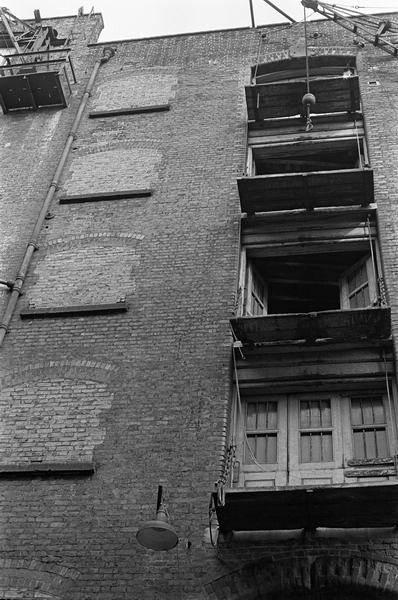
West Kent or Hibernia Wharves, Southwark, 1978
14v54: Southwark, wharves, Victorian
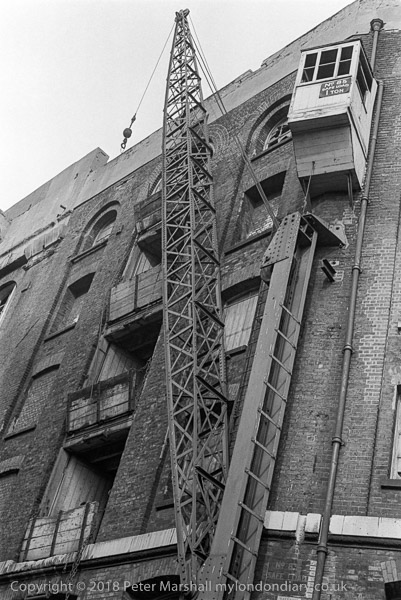
West Kent Warehouses, St Mary Overy’s Wharf, Southwark, 1978
14v51: Southwark, works, derelict,
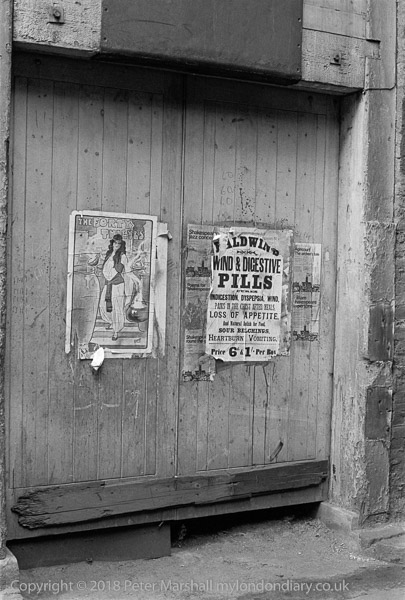
Clink St, Southwark, 1978
14v55: Southwark, wharves, Victorian, posters,
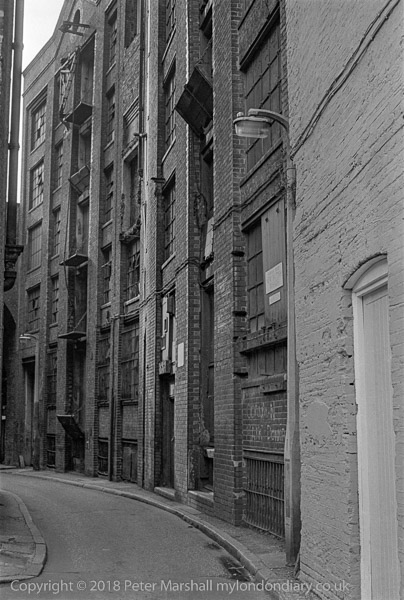
Clink St, Southwark, 1978
14v56: Southwark, wharves, Victorian, posters,
More to follow….
______________________________________________________
There are no adverts on this site and it receives no
sponsorship, and I like to keep it that way. But it does take a considerable amount of my time and thought, and if you enjoy reading it, a small donation – perhaps the cost of a beer – would be appreciated.
My London Diary : London Photos : Hull : River Lea/Lee Valley : London’s Industrial Heritage
All photographs on this and my other sites, unless otherwise stated, are taken by and copyright of Peter Marshall, and are available for reproduction or can be bought as prints.
To order prints or reproduce images
________________________________________________________